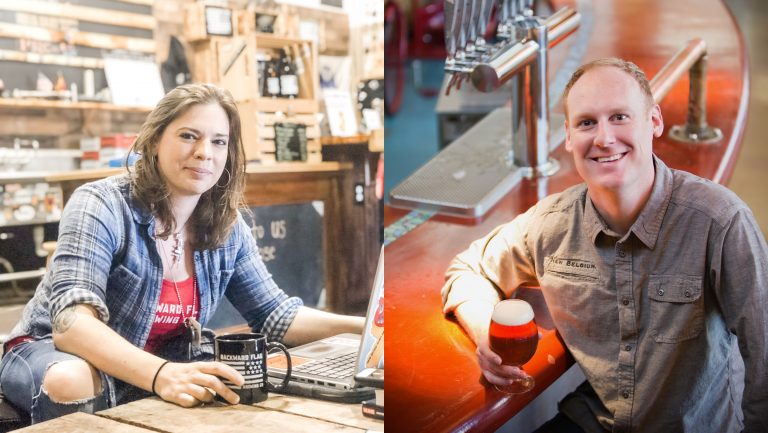At times, bar and restaurant patrons send back a beer not because they don’t like the style but because they claim it contains an “off-flavor”—an unpleasant taste or smell that in most cases shouldn’t be present. Although brewers do their best to release perfectly made products, sometimes a beer can develop an unintended flaw at some point during brewing, packaging, storing, transporting, or serving. So how do servers know if a beer is, indeed, tainted? Here’s a guide to eight of the most common off-flavors associated with beer and what servers should know about them—with a reminder that most off-flavors have their place in at least one or two beer styles.
1. Acetaldehyde (green apple)
During fermentation, yeast converts starches into alcohol and carbon dioxide (CO2) in part by reducing acetaldehyde to ethanol. According to Gwen Conley, the director of quality assurance at Cutwater Spirits in San Diego, and who was formerly the director of production and quality at Port Brewing and The Lost Abbey in San Marco, California, low levels of acetaldehyde can be present without causing trouble in some styles, like bière de garde. However, she says, the compound can manifest at inappropriately high levels when a brewer pitches too much yeast into the fermentation tank, ferments too quickly, ferments at unacceptably high temperatures, or takes the liquid off the yeast before the acetaldehyde converts to ethanol.
2. Butyric acid (baby vomit)
Commonly produced by a bacterial infection developed during brewing, butyric acid can also arise from poor sanitation during packaging, says Zalika Guillory, a co-owner of La Taberna Lupulo craft beer bar in San Juan, Puerto Rico. “No detectable amount of butyric acid is acceptable,” she says, “so you should stop serving any beer that you suspect of being contaminated and inform the brewery or distributor.” Guillory adds that with the popularity of kettle sours, you may encounter this off-flavor more frequently because sour mashing provides an ideal environment for the bacteria that cause butyric acid to grow.

Don’t miss the latest drinks industry news and insights. Sign up for our award-winning newsletters and get insider intel, resources, and trends delivered to your inbox every week.
3. Diacetyl (buttered popcorn)
Though winemakers welcome diacetyl in their buttery Chardonnays, Matt Meadows, the director of field quality for New Belgium Brewing in Fort Collins, Colorado, and the Brewers Association’s draft beer quality ambassador, says it’s considered an off-flavor in pretty much every beer style. During fermentation, he explains, yeast produces precursors to diacetyl called vicinal diketones (VDKs). Toward the end of fermentation, the yeast absorb the VDKs, but if the brewer cuts the process short, remaining VDKs will lead to diacetyl. However, Meadows says, “more commonly, especially when found in draft beer, diacetyl is a by-product of a bacterial infection. Anaerobic bacteria like lactobacillus and pediococcus begin to grow when hygiene standards are inadequate.”

4. Dimethyl sulfide (aka DMS; canned corn, cabbage)
While DMS can provide a signature flavor to pilsners, it most often provokes concern over the quality of pale malts (which carry high amounts of a compound that’s produced during barley germination and breaks down into DMS during mashing or boiling) or the boiling rate of the wort, says Chelsea Martin, the director of quality at Tonewood Brewing in Oaklyn, New Jersey. Malt, particularly malt that hasn’t gotten kilned long, releases DMS during the boiling stage of brewing, while at the same time, the hot water boils it away. “It’s super volatile; it can be boiled off,” Martin says. “But as wort chills, it can start to build again at temperatures between boiling and 140°F, so it’s important [for the brewer] to chill quickly!”
5. Hydrogen sulfide (rotten eggs)
Hydrogen sulfide is normally produced by yeast during early lager fermentation and is typically removed during fermentation when carbon dioxide bubbles help carry the molecules out of the beer, says Matt Farber, the director of the Brewing Science Certificate Program at the University of the Sciences in Philadelphia. A normal, healthy fermentation, Farber says, should reduce hydrogen sulfide to acceptable levels. The appearance of hydrogen sulfide in finished beer—other than English Burton ales, which use hard water containing higher-than-normal levels of hydrogen sulfide—may indicate poor yeast health. “To help remove excessive hydrogen sulfide,” says Farber, “brewers may be able to force carbon dioxide bubbles through the bottom of a tank in an attempt to ‘scrub’ the beer.”

6. Mercaptan (rotten vegetables, skunk)
Found in most beers at low levels, methanethiol, or methyl mercaptan, forms as yeast metabolizes at the end of fermentation, says Cutwater’s Conley, who adds that “it is one of the main chemicals responsible for bad breath and flatulence.” The sulfury odor usually dissipates, but it occasionally persists if there’s too much of that sulfury odor to start with and can even become more pronounced during secondary fermentation if too many yeast cells kill themselves off. Mercaptan may be introduced by dry hopping, too, Conley says, and can be dramatically reduced by introducing copper sulfate.
Tonewood’s Martin points out that mercaptan is the same chemical skunks release from glands on their backsides and that it can be blamed for the skunky smell that’s emitted when a beer is exposed to light, most often after it’s packaged in clear or green glass. This smell, explains Guillory, of La Taberna Lupulo, is the by-product of the chemical reaction that occurs when the hop alpha acids—the bittering agents in beer—are exposed to light. “Though it won’t make you sick,” Guillory says, “beer is never supposed to smell like a skunk, and any detectable level means that the beer has already been light struck.” Brewers tend to avoid this by canning or bottling in brown glass.
7. Metallic (metal, blood)
According to Brian Pylant, a nationally ranked Beer Judge Certification Program judge, the most common source of metallic off-flavors in beer is contact with metal components in the brewery. Besides contact with non-inert metals, older water pipes, especially from wells, can also impart metallic flavors to the water they carry, he says, and if this water is used for brewing, those flavors can pull through to the finished beer. “If [a brewer’s] primary source for brewing water has any sort of metallic characteristics,” Pylant says, “it may be best to treat [the] water.”

8. Oxidation (cardboard)
Canned and bottled beer will typically show signs of oxidation after aging. As much as oxygen is avoided during production, there will always be a small amount working on the final product, says Certified Cicerone Torie Fisher, the owner of Backward Flag Brewing in Forked River, New Jersey. Warm temperatures will accelerate the effects of oxygen; retailers can slow and reduce this by keeping the product stored cold and rotating stock regularly. “Oxidation is a normal part of the aging process and not always undesirable,” says Fisher. “Typically in stronger, darker beers, it can present itself with notes of honey and a vinous character which tends to be complementary.”
Unfortunately, most flaws in beer develop between the brewery and storage, which means that by the time they’re identified by a customer or server, nothing can be done other than to pull the beer and notify the manager—who should then notify the distributor. But having a better sense of what causes off-flavors in beer and being able to identify them can help servers not only understand when a customer’s beer needs to be replaced but how to communicate the problem in a knowledgeable way that benefits the overall customer experience.

Dispatch
Sign up for our award-winning newsletter
Don’t miss the latest drinks industry news and insights—delivered to your inbox every week.
Tara Nurin is the beer and spirits contributor to Forbes, the drinks columnist for New Jersey Monthly, a cohost of the What’s on Tap TV show, and a writer for publications like Food & Wine, Wine Enthusiast, Vice Munchies, and VinePair. She is a BJCP-certified judge, teaches a for-credit university beer class, and leads beer seminars for institutions like the Smithsonian. The Camden, New Jersey, homeowner has won two first-place awards from the North American Guild of Beer Writers, founded the state’s first beer education group for women, and volunteers as the archivist for the Pink Boots Society.







